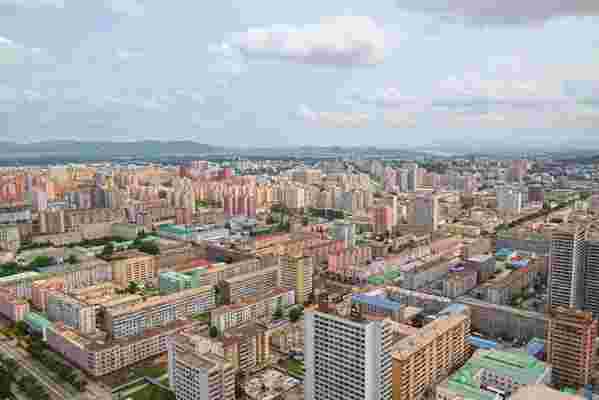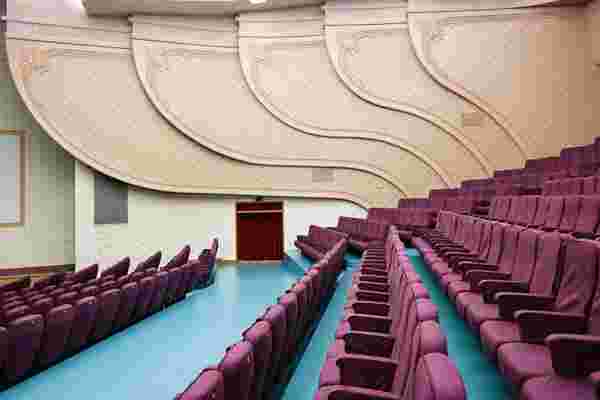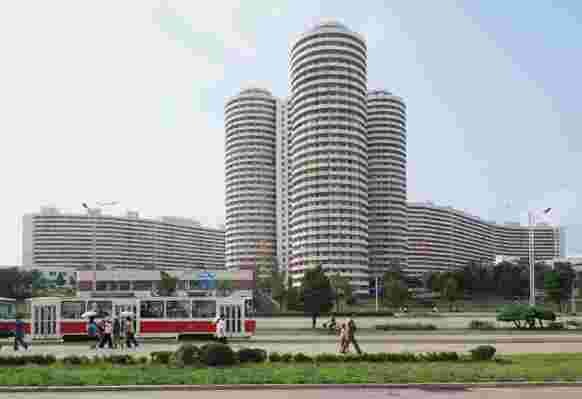In 1953, a new Pyongyang rose out of the ashes of the Korean War. That year, the North Korean capital city was reimagined by its founding father, Eternal President Kim Il Sung, as a "great garden of Juche architecture," ( Juche is the national ideology of self-reliance). The Moscow-trained architect Kim Jong Hui drew up plans for the totalitarian president's ideal city, one where only 25 percent of land area is occupied by buildings, where wide, axial boulevards link ceremonial squares and frame monumental vistas, and where (surprisingly) colorful structures form a pastel panoramic.
The scene is the same one that government elite, other residents, and select foreign visitors see today. From monuments to housing developments, the architecture of this oft-hidden place may have been steered by the neoclassicism favored by the Soviets, but its roots are entirely Korean. Though new construction has increased rapidly under current Supreme Leader Kim Jong-Un, even mirror-glass towers like the Ryugyong Hotel embrace the traditional shapes of Korean temples and pagodas, with octagonal plans and tiers.

A view from the Tower of the Juche Idea reveals the pastel-colored structures that mark North Korea's capital.
While it may seem a harmless pre-Division allusion, the Pyongyang building style is entirely tactical. Historic references seek to legitimize the North Korean regime by placing its capital within the historic architectural canon. In his recent book Inside North Korea , ($60, Taschen ), journalist and photographer Oliver Wainwright documented his 2015 trip to the capital, which was facilitated by a Beijing-based tour company. Approaching the country as a tourist gave him increased (though strictly guided) access to what he describes as a "very theatrical" city and its socialist-fairy-tale designs.
"It's the kind of city that feels as if it's designed as stage sets," he reflected. "Your gaze is very much directed towards its monuments."


Inside, structures flow in a ceremonial way, no matter the building typology, says Wainwright. They are always symmetrical, often with naves and colonnades, much like Christian churches. And, as mandated by state law, portraits of Kim Il Sung and Kim Jong-Un are hung alone, high up on one wall. Interiors are also often as colorful as their exteriors. Pastel blues, greens, and pinks feature heavily and pairings are often opposites on the color wheel. Though guides would not reveal the colors' significance, Wainwright looked to South Korea for clues. These hues are similar to those on the traditional South Korean hanbok dress, another way to insert North Korea's ideologies into the previously unified country's history, he devised.
Since Kim Jong-Un's regime began seven years ago, the capital skyline has seemingly gained a new high-rise district annually. Although the structures may not be built in the same retro, science-fiction-esque style of their neighbors, symbolism is still a defining feature. The riverside towers of Mirae Scientists Street, for example, were constructed for "scientists of the future," all in the shape of the third symbol of North Korean socialism, the intellect's calligraphy brush. Monumental architecture is often thought of as a soft power, but in North Korea, the entire built world supports ideology. As architect and designer Gaetano Pesce summed in a recent lecture at Columbia University's GSAPP, "Architecture is not a decoration, it is much more important than that. Architecture is a representation of the identity of the place. It's the identity that is in the air."
RELATED: North Korea's Metro Stations Are Not What You Would Expect
